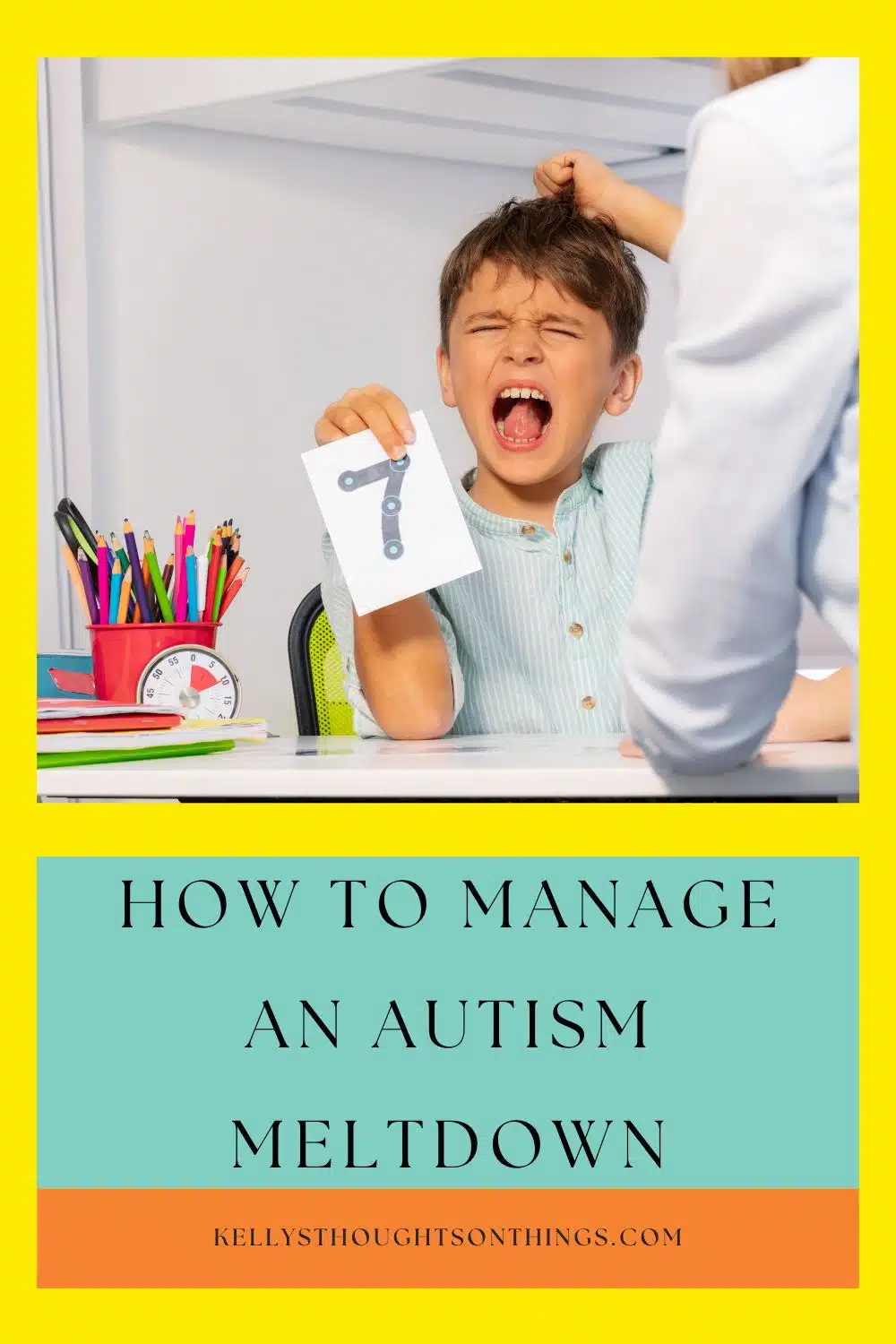The key to managing an autism meltdown is first to understand them. This means identifying why they are occurring and spotting the warning signs that lead up to them. There are many different reasons why meltdowns happen, but some of the most common triggers include changes in routine, fatigue, hunger, and overstimulation.

Once you know what triggers a meltdown, you can start to look for warning signs that one is about to occur.
These may include repetitive behaviors, withdrawing from social interaction, or becoming increasingly irritable.
When you see these signs, taking action is crucial to diffuse the situation.
This may mean removing your child from the trigger environment, providing reassurance and support, or simply giving them a chance to rest and relax.
You can help your child through even the toughest meltdowns with understanding and patience.
When parents recognize events and actions that could trigger a meltdown, they can avoid having one altogether by removing potential sources of stress in time.

The Difference Between a Meltdown and a Tantrum
Most of us are familiar with tantrums. We’ve all had them, and we’ve all seen them. They usually happen in young children when they don’t get their way.
They usually involve crying, screaming, and sometimes hitting or kicking. And usually, after a few minutes, the child calms down and goes on with their day.
Autism meltdowns are different. They can happen at any age, and they’re not used as a manipulative tool.
A meltdown for a child with autism is a complete loss of control. The child may cry, scream, hit, kick, or even head-bang.
They may try to hurt themselves or others. And it can go on for minutes or even hours.
If you’re faced with an autism meltdown, the best thing you can do is to stay calm. It’s important to remember that the child is not doing this on purpose.
They’re simply overwhelmed and can’t cope with the situation.
Sign Up Below For Your Free Autism Check List!
Why Meltdowns Happen
When an autistic child is having a meltdown, it can be a heartbreaking and frustrating experience for both the child and the parent. meltdowns are often the result of sensory overload, communication difficulties, or intense emotions.
While it is impossible to prevent meltdowns completely, there are some things that parents can do to help minimize their occurrence and provide support during these difficult times.
One of the most important things to remember is that autistic children are not having a tantrum or misbehaving on purpose.
It is also essential to stay calm and avoid yelling or using any type of physical punishment.
Instead, try redirecting the child’s attention to something else or providing them with a sensory-friendly activity.
If the meltdown occurs in public, removing yourself from the situation is best as quickly as possible.
This can be difficult, but it is essential to remember that you are not alone and there is help available.
With patience, understanding, and a bit of trial and error, you can help your autistic child navigate their meltdowns in a healthy and supportive way for everyone involved.

How To Recognize an Autistic Meltdown
When an autistic individual has a meltdown, it can be an extremely difficult and frustrating experience for the individual and their caregivers.
Meltdowns can manifest in a variety of ways, including both physical and emotional outbursts.
An autistic meltdown can include:
- Social withdrawal.
- Running away or bolting.
- Zoning or tuning out.
- Screaming or yelling.
- Hitting, kicking, or aggression toward others.
- Self-harming behaviors, such as biting, hitting, or head banging.
- Extreme crying.
Parents of children with autism know all too well the frustration and heartache that can come with autism meltdowns.
While these episodes can be triggered by several different factors, such as sensory overload, anxiety, or communication difficulties, there are some things that parents can do to minimize their frequency.
How To Manage an Autism Meltdown
Managing Autism meltdowns is crucial to caring for someone on the spectrum. You can take several steps to manage these meltdowns, including creating routines and using distractions when possible.
One of the most challenging aspects of autism is dealing with meltdowns. When a meltdown is already happening, it can be challenging to know what to do.
However, there are some things that you can try to help your child.
Leave the room or location to help your child calm down
When an autistic child is having a meltdown, it can be challenging to know what to do. However, one strategy that can be helpful is to leave the room or location.
This can give the child a much-needed break from stimulation, allowing them to calm down more quickly.
It can also help create a safe space for the child, where they can feel in control and free from overwhelming sensory input.
Finally, leaving the room can also give the child time to process what is happening and figure out how to cope with their emotions.
While it may not be easy, sometimes it is necessary to step away to help an autistic child calm down.

Use calming devices like a fidget toy, noise-canceling headphones, or a weighted vest
Managing autism meltdowns can be a difficult and overwhelming task.
But some simple and calming devices can help. Noise-canceling headphones can help to block out overwhelming noises.
A weighted vest can provide a sense of security and comfort. And a fidget toy can help to soothe and distract.
These devices can be essential tools in managing autism meltdowns.
And they can help to provide a sense of calm and peace in the midst of chaos.
It is vital to keep your face and voice neutral
This will help to avoid triggering the child’s meltdown. Second, be at arm’s length in case the child reaches out.
This will help to prevent the child from becoming further agitated. Finally, stay calm and remain consistent.
This will help the child to feel safe and secure, and eventually, the meltdown will subside.
Create a safe place for your child
This can be done by removing any objects that could be used as weapons, clearing a space on the floor for your child to lie down, and using soft materials to cushion any falls.
Creating a safe space can help prevent injuries during a meltdown and allow your child to release their emotions safely and healthily.
Keep yourself calm as your child can feel your frustration
Managing an autism meltdown can be incredibly frustrating, but it is essential to remain calm throughout the process.
If you become frustrated or angry, your child will likely pick up on those cues and further escalate the meltdown.
Instead, try to stay calm and provide reassurance.
Speak in a soft, comforting voice and offer simple explanations of what is happening.
You may also want to provide physical comforts, such as a hug or gentle touch.
By remaining calm and collected, you can help your child to manage autism meltdowns more effectively.

Make an Emergency Meltdown Kit
Another item that I find that comes in handy when I am trying to manage an Autism meltdown is an emergency meltdown kit.
A meltdown kit is a customized set of objects to help prevent or de-escalate a child’s meltdown.
The kit can be tailored to the individual child’s needs and may include items such as toys, calming devices, sensory items, or other objects that the child finds comforting.
A meltdown kit can help reduce the stress and anxiety associated with meltdowns and make managing them much easier for both children and parents.
Here are some questions to ask yourself when creating your own meltdown kit:
- What kind of sensory input does my child need? This might include weighted blankets, fidget toys, or noise-canceling headphones.
- What kind of activities does my child find calming? This might include things like reading, drawing, or listening to music.
- What kinds of foods does my child find soothing? This might include comfort foods or snacks that are easy to eat quickly.
By taking the time to answer these questions, you can tailor your autism meltdown kit specifically to your child’s needs.
As a result, you’ll be better prepared to manage meltdowns when they occur.
Here are some items that can be included in your child’s kit to help manage meltdowns:
- Fidget toys, sensory objects (kinetic sand, play putty, slime, stress ball)
- sunglasses
- noise-canceling headphones
- favorite music
- bubbles
- weighted vest, weighted stuff toy
- favorite toy
- puzzles
- favorite non-perishable snack
- musical instrument (whistle, harmonica)
When your child shows signs of stress or anxiety, you can offer them these items to calm them down.

Managing autism meltdowns, tantrums, and aggression may all be part of raising a child on the spectrum.
While these can be difficult to manage at times, having the right strategies in place can significantly improve your child’s ability to regulate emotions in the future.
As a parent, you know your child best and should keep looking for the most effective and safest ways to help your child during a meltdown or tantrum.
Managing autism is a process of trial and error.
What works for one child might not work for another.
The important thing is to never give up hope and to always keep searching for new ways to help your child cope with this condition.
Managing autism can be difficult, but it is possible with the right amount of love, support, and understanding.
